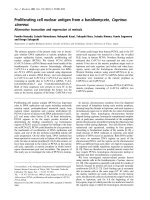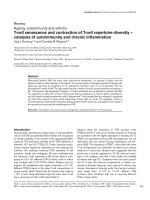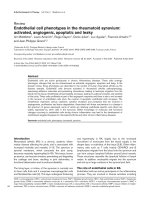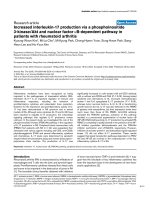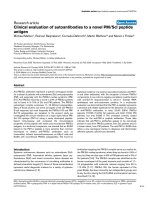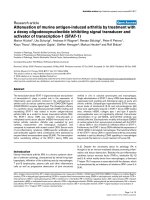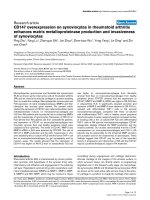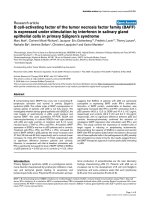Báo cáo Y học: Proliferating cell nuclear antigen from a basidiomycete, Coprinus cinereus Alternative truncation and expression at meiosis pptx
Bạn đang xem bản rút gọn của tài liệu. Xem và tải ngay bản đầy đủ của tài liệu tại đây (672.36 KB, 11 trang )
Proliferating cell nuclear antigen from a basidiomycete,
Coprinus
cinereus
Alternative truncation and expression at meiosis
Fumika Hamada, Satoshi Namekawa, Nobuyuki Kasai, Takayuki Nara, Seisuke Kimura, Fumio Sugawara
and Kengo Sakaguchi
Department of Applied Biological Science, Faculty of Science and Technology, Science University of Tokyo, Japan
The primary purpose o f the present study was to investi-
gate whether DNA replication at meiotic prophase also
requires replication factors, especially proliferating cell
nuclear antigen (PCNA). We cloned PCNA cDNAs
(CoPCNA) from a cDNA library made from basidia of the
basidiomycete, Coprinus cinereus. Interestingly, although
CoPCNA is a s ingle-copy gene in the g enome, two dier-
ent PCNA cDNA species were isolated using degenerate
primers and a meiotic cDNA library, and were design ated
as CoPCNA-a and CoPCNA-b. CoPCNA-b was made by
truncating at speci®c sites in CoPCNA-a mRNA, 5¢-AA-
GAAGGAGAAG-3¢ and 5¢-GAAGAGGAAGAA-3¢.
Both of these sequ ences were present in exon IV in the
genomic sequence, and interestingly the former was the
same as the i nverse sequence o f t he latter. C oPCNA-a was
107 a mino acids larger t han human PCNA, and so the 107
amino-acid sequence was inserted in a loop, the so-called
D
2
E
2
loop, in human PCNA. Northern blotting analysis
indicated that CoPCNA was expressed not only at pre-
meiotic S but also at the meiotic prophase stages such as
leptotene and early zygotene, just before and when kary-
ogamy occurs and the homologous chromosomes pair.
Western blotting analysis using anti-(CoPCNA-a)Igre-
vealed that at least two CoPCNA mRNAs before a nd after
truncation w ere translated at t he meiotic prophase as
CoPCNA-a and CoPCNA-b.
Keywords: Coprinus cinereus; Coprinus PCNA (CoPCNA);
meiotic prophase; truncating of CoPCNA mRNA; two
CoPCNA species.
Proliferating cell nuclear antigen (PCNA) has important
roles in DNA replication and repair including nucleotide
excision repair, postreplicational mismatch repair, base
excision repair, apoptosis and cytosine methylation [1].
PCNA is known t o interact with DNA polymerases d and e,
p21 and many other factors [2±6]. In these interactions,
PCNA appears t o be t he major protein involved in
determining the binding coun terpart, e.g. homologous
regions of FEN-1 and p21 compete for binding to the same
site on PCNA [7]. PCNA could therefore be a k ey protein in
the mechanism of coordination of DNA replication and
repair, and one of the key proteins controlling mitotic cell
cycle progression. On the other hand, DNA synthesis has
been reported to occur not only at S phase of the meiotic cell
cycle, but also at meiotic prophase [8±10]. In this context, we
have been interested in the role(s) of PCNA in the meiotic
cell cycle, especially at meiotic prophase in which homol-
ogous chromosomes pair and recombine. The purpose of
this study was to investigate the roles of PCNA in meiosis.
In meiosis, chromosomes co ndense f rom the dispersed
state typical of interphase during early meiotic prophase,
forming l ong t hin threads i n l eptotene, and eac h acq uire s a
proteinaceous axial core to which the two sister chromatids
are attached. Then, homologous chromosomes become
aligned during zygotene, forming the synaptinemal complex
and, at pachytene, nonsister chromatids of the completely
paired chromosomes recombine forming t he chiasmata that
become visible during diplotene. Two cell divisions follow,
reductional and e quational, resulting in four gametes.
According to biochemical studies of lily meiosis [8±10], a
small amount of DNA replicates at zygotene, and repair
synthesis of DNA occurs at pachytene. Both DNA synthe-
ses occur on nonsense DNA regions on parts of t he
chromosomal DNA, and the regions on the chromosomal
DNA are different from each o ther; very h igh Cot se quences
at zygotene and middle repetitious sequences at pachytene
[8±10]. There are therefore two possible meiotic events that
may require PCNA, homologous chromosome pairing at
zygotene and their recombination a t pachytene.
We have investigated meiosis-related protein factors
using meiotic cells in the basidiomyc ete, Coprin us ci nereus
[11±20]. This organism is especially well suited for studies of
meiosis, because its meiotic cell cycle is long and n aturally
synchronous [16,19,21±23]. Each fruiting cap is extremely
rich in meiotic cells at the same stage (10
6
±10
7
cells), and
the nuclear numbers are easily observable. In the meiotic
cycle, the dikaryonic cells are at premeiotic stages f rom t he S
phase to leptotene, and for 6 h the beginning of the
karyogamy stage (at which point the two nu clei are fused) is
the zygotene stage a t which the homologous chromosomes
Correspondence to K. Sakaguchi, Department of Applied Biological
Science, Science University of Tokyo, 2641 Yamazaki , Noda-shi,
Chiba-ken 278, Japan. Fax: + 81 471 23 9767,
Tel.: + 81 471 24 1501 (ext. 3409), E-mail,
Abbreviations: PCNA, proliferating cell nuclear ant igen; CoPCNA,
PCNA cDNA.
(Received 31 J uly 2 001, revised 22 October 2001, ac cepted 25 October
2001)
Eur. J. Biochem. 269, 164±174 (2002) Ó FEBS 2002
pair. The chromosomes then recombine at pachytene. It is
therefore possible to precisely characterize meiosis-related
PCNA in relation to each of the meiotic events. In the
present paper, we found Coprinus PCNA proteins with
special properties from characterization of a Coprinus
PCNA gene in the cells at meiotic prophase. Interestingly,
unlike m ammals and yeast, the cells produced two species of
Coprinus PCNA protein, although the gene is present in a
single copy in the genome. Consistent with the p redicted role
in meiosis, the Coprinus PCNA mRNAs were expressed at
limited meiotic prophase stages.
MATERIALS AND METHODS
Culture of
C. cinereus
and collection of the fruiting
bodies
The basidiomycete C. cinereus (American Type Culture
collection no. 56838) was used in this study. The culture
methods used here were nearly identical to those described
previously [21]. Culture dishes (6 cm in height and 9 cm in
diameter) containing sterile horse manure were inoculated
with a dikaryotic stock culture of C. cinereus on day 0.
These cultures were incubated from d ay 0 to day 7 at
37 °C in total darkness and from day 7 onwards at 25 °C
under a light cycle of 16 h light and 8 h dark to allow
photoinduction of fruiting body formation. The light cycle
started at 05:00(K + 1). Karyogamy was de®ned as the
time at which 5% of all basidia had fused nuclei, and
interestingly began at 04:00(K + 0), 1 h before the light
was turned on. Fruiting bodies were undergoing karyog-
amy from 04:00(K + 0) to 09:00(K + 5) (i.e. in late
leptotene to early zygotene), they were in pachytene from
10:00(K + 6) to 11:00(K + 7), and then were undergoing
division from 12:00(K + 8) to 14:00(K + 10). Under
these conditions, meiotic cells all at the same stage of
prophase could be readily obtained. T he fruiting caps were
harvested, quickly frozen in liquid N
2
, and then stored at
)80 °C until used.
CDNA and cloning of
Coprinus
proliferating cell
nuclear antigen (CoPCNA)
Culture of Escherichia coli and phage, e xtraction of plasmid
DNA, electrophoresis of DNA and RNA, were carried out
according to the methods described previously [24] unless
otherwise speci®ed.
To isolate homologous PCNA cDNA, two primers were
used corresponding to amino-acid motifs conserved in
human PCNA, Schizosaccharomyces pombe PCNA, Droso-
phila melan ogaster PCNA and Arabidopsis thaliana PCNA:
sense primer (5¢-CCGGCATCAACCTGCARDSNATG
GA-3¢) and antisense primer (5¢-GATCGATGT
CCATCAGCTTCAYNTCRWARTC-3¢)(N A, C, G
or T; R AorG;Y CorT;W A o r T). The primers
were used in PCR reactions with cDNA generated f rom
poly(A)+ RNA isolated from fruiting bodies of C. cinereus
as template. PCR was performed with 1 lgofthecDNAas
a t emplate i n a volume of 50 lL in the presence of 2 l
M
of
each of the two primers in a buffer containing 250 m
M
dNTPs (Amersham P harmacia Biotech), 10 m
M
Tris/HCl,
pH 8.3, 50 m
M
KCl, 1 . 5 m
M
MgCl
2
, 0.05% Nonidet P-40,
and 2 U of ExTaq thermostable DNA polymerase (Takara).
Cycling conditions were: 94 °Cfor2min;94°Cfor30s;
50 °Cfor1min;72°C for 1 m in; 40 cycles, followed by a
10-min extension at 72 °C. The major 200-bp PCR band
was subcloned into the pGEM-T vector (Promega) and
sequenced. To determine the 5¢ and 3¢ termini of the gene,
5¢ and 3¢ RACE PCR was performed.
The DDBJ/EMBL/GenBank accession number of the
nucleotide sequence reported in this paper is AB05 6703 for
the proliferating cell nuclear antigen (CoPCNA).
Genomic DNA isolation and Southern hybridization
analysis
Genomic DNA was isolated from Coprinus myc elium tissue
anddigestedwithrestrictionenzymessuchasXhoI, NdeI,
EcoRI and Bam HI [25]. The DNA fragments were fraction-
ated on 1% agarose gels, transferred on Hybond-N
+
membranes [24]. The hybridization procedure was per-
formed [26]. The probe (amino-acid residues 131 to 223; see
below) was l abeled with
32
P using a Multiprime DNA label
kit ( Amersham Pharmacia Biotech). After prehybridization,
hybridization was carried out at 42 °C f or 16 h, followed b y
washing with 2 ´ NaCl/P
i
/EDTA, 1% SDS at 65 °Cfor
15 min, 1 ´ NaCl/P
i
/EDTA, 1% SDS a t 65 °C for 15 min,
and 0.2 ´ NaCl/P
i
/EDTA, 1% SDS at 65 °C for 15 min.
Search for three-dimensional structure of human
and
Coprinus
PCNA
To simulate the three-dimensional structures of the PCNAs,
modeling o f the human PCNA protein was compared w ith
the CoPCNA-a trimer based on the data for the human
PCNA protein obtained by computer analysis. Computer
analysis was performed with
INSIGHT II
binding site analysis
(Molecular Simulations Inc., San Diego, CA, USA, 1999)
[27±29].
RNA isolation and northern hybridization analysis
Total RNA was prepared from caps of C. cinereus at
meiotic prophase using Trizol (Gibco-BRL) according to
the manufacturer's protocol.
RNA s amples were fractionated on 1 .2% agarose-
formaldehyde gels [30]. Total RNA (20 lg) from the caps
at each meiotic stage and from the somatic tissue were
loaded into each lane. The agarose gel was staine d with
ethidium bromide and blotted overnight in 20 ´ NaCl/P
i
/
EDTA onto Hybond-N
+
membranes (Amersham Phar-
macia Biotech). The two probes (amino acids 131 t o 223 for
both CoPCNA-a and CoPCNA-b,and227to268for
CoPCNA-a alone; see below) were labeled with
32
P, then
hybridized as described f or Southern analysis.
Preparation of riboprobes and
in situ
hybridization
Riboprobes for in situ hybridization were labeled with
digoxigenin-11-rUTP using a DIG RNA Labeling Kit
(Boehringer Mannheim) according to the manufacturer's
protocol. The riboprobes used were a mino acids 131 to 223
for both CoPCNA-a and CoPCNA-b, and residues 227 to
268 for CoPCNA-a alone; see below. The riboprobes were
subjected to mild alkaline hydrolysis b y h eating at 60 °Cfor
53 min in 0.2
M
carbonate/bicarbonate buffer and used at a
Ó FEBS 2002 Alternative truncating of Coprinus PCNA mRNA (Eur. J. Biochem. 269) 165
concentration of 2 mgámL
)1
the fruiting c aps were ®xed
overnight at 4 °C with a mixture of 4% (w/v) paraformal-
dehyde and 0.25% (v/v) glutaraldehyde in 50 m
M
sodium
phosphate buffer ( pH 7.2). The ®xed tissues were dehydrated
in a series o f xylene and ethanol and embedded in paraf®n.
Embedded tissues were sectioned at a thickness of 5 lm,
and placed on microscope slides precoated with poly
L
-lysine. Sections were deparaf®nized with xylene a nd
rehydrated through a graded ethanol series. They were
subsequently pretreated with 10 mg ámL
)1
of proteinase K
in 100 m
M
Tris/HCl, pH 7.5, a nd 50 m
M
EDTA at 37 °C
for 30 min, dehydrated in a graded ethanol series, and d ried
under vacuum for 2 h. Hybridization and detection of
hybridized riboprobes were performed [31].
Overexpression and puri®cation of CoPCNA protein
CoPCNA coding region was ampli®ed using the 5¢ sense
primer 5¢-GGAATTCCATATGCTTGAAGCCAAACT
CGCAG-3¢ and 3¢ antisense primer 5¢-CGAGCTCGGG
TCGTCACCAATCTTAGGTGCG-3¢, a nd cloned into
pET21a (Novagen). The plasmid constructs were intro-
duced into BL21(DE3)pLysS (Novagen).
Transformed E. coli were grown at 37 °Cin2´ yeast/
tryptone medium with 1% glucose and 50 mg ámL
)1
amp-
icillin. Cells were grown to a D
600
of 0.8. Recombinant
protein synthesis was induced by addition of 1 m
M
IPTG,
and after 3 h the cells we re harvested by centrifugation. The
cell pellets were resuspended in liquid N
2
andstoredat
)80 °C. The cell pellets were resuspended in lysis buffer
(20 m
M
Tris/HCl, pH 6.5, 10% glycerol, 500 m
M
NaCl,
5m
M
imidazole), containing 5 m
M
2-mercaptoethanol and
the protease inhibitors phenylmethanesulfonyl ¯uoride
(1 m
M
), leupeptin (1 l
M
) and pepstatin A (1 l
M
). Cells
were lysed by a ddition of 1 mgámL
)1
of lysozyme and
stirred on ice for 30 min, then sonicated and Triton X-100
was added to 0.1%. Insoluble material was removed by
centrifugation at 15 000 r.p.m. for 15 min. Proteins were
loaded onto a 1- mL HiTrap Chelat ing column (Amersham
Pharmacia Biotech). The column w as washed successively
with buffer A (20 m
M
Tris/HCl, pH 6.5, 10% glycerol,
500 m
M
NaCl, 0.02% NP-40) containing 5 m
M
imidazole.
The bound proteins were eluted with buffer A containing
400 m
M
imidazole. Fractions of proteins were identi®ed by
SDS/PAGE, pooled and dialyzed. The dialysate w as loaded
onto a Mono Q HR5/5 column (Amersham Pharmacia
Biotech) equilibrate d with buffer B (50 m
M
Tris/HCl
pH 6.5, 10% glycerol, 2 m
M
EDTA, 5 m
M
2-mercaptoeth-
anol). After washing, fractions were collected with 40 mL of
alineargradientof0±0.7
M
NaCl in buffer B. The protein
concentrations were determined using a Bio-Rad protein
assay kit with c-globulin as the standard.
Immunological analysis and immuno¯uorescence
microscopy
A polyclonal antibody against t he CoPCNA -a protein was
raised in rabbit u sing the puri®ed proteins. Western blotting
analysis was carried out [32]. Anti-(rabbit IgG) Ig conju-
gated with alkaline phosphatase (Promega) was used as
a s econdary antibody with nitroblue tetrazolium and
5-bromo-4-chloro-3-indolyl phosphate as substrates of
alkaline phosphatase.
Immunostaining o f Coprinus fruiting caps was carried o ut
[33]. The paraf®n sections of the fruiting caps described
above i n the in situ hybridization section were u sed. The cells
were incubated for 1 h with the antibody against each of
the CoPCNA p roteins. The antibodies against each of the
CoPCNA proteins were diluted at 1 : 100 before use. The
cells were the n treated for 1 h with FITC- conjugated anti-
(rabbit IgG) Ig (Sigma Chemical Co.) conjugated with
Alexa ¯uoro 568, which was diluted 1 : 1000 as a secondary
antibody. T hen, the cells were also stained with a solution
of 20 lgáL
)1
4¢,6-diamido-2-phenylindole dihydrochloride
n-hydrate (DAPI) for 5 min The specimens were examined
under a ¯uorescence microscope (Olympus BH-2).
Immunoscreening
Using previously described rabbit anti-CoPCNA Ig,
immunoscreening was carried out with kZAPII cDNA
library from the c aps at e ach meiotic stage of C. cine reus.
From the i solated plaques, plasmid DNA was p repared by
the in vivo excision protocol using the ExAssist/SOLR
system (Stratagene).
RESULTS AND DISCUSSION
Isolation and characterization of PCNA homologous
cDNA in
Coprinus
meiocytes
As described in t he introduction, proliferating cell nuclear
antigen (PCNA) might play some role(s) in the meiotic cell
cycle, especially at meiotic prophase. We report here that i n
a basidiomycete, C. cinereus , PCNA message was speci®-
cally expressed in meiotic prophase stages at which homol-
ogous chrom osomes p air (zygotene) and recombine
(pachytene). In lily microsporocytes small amounts of
DNA synthesis were required for synaptinemal complex
formation (zygotene), and for recombination b etween
homologous DNAs (pachytene) [8]. The former synthesis
was replication-type, and the latter was repair-type. These
observations indicate that accessory proteins of DNA
synthesis such as PCNA may have important roles in
meiosis-speci®c biochemical e vents. We ®rst tried to i dentify
the PCNA homolog in C. cine reus, and then investigated
the meiotic stage-speci®c transcription. Unexpectedly, we
found the production of two species of PCNA protein in
C. cinereus .
To isolate the Coprinus PCNA homolog, t wo d egenerate
PCR primers (see Materials and methods) were used for
PCR with cDNA produced from poly(A)+ RNA isolated
from fruiting bodies of C. cine reus at meiotic prophase as
the template. As the c DNA clones obtained were all
incomplete in length, we attempted to isolate full-length
cDNA by 5¢ and 3¢ RACE. Fortunately, we were able to
obtain the 5¢ and 3¢ ends. The DDBJ/EMBL/GenBank
accession number of the nucleotide sequence reported in this
paper i s AB056703 for the proliferating cell nuclear antigen
(CoPCNA).
A polyclonal antibody against CoPCNA-a protein was
raised in a rabbit using the puri®ed protein. W estern
blotting analysis revealed that the anti-CoPCNA Ig recog-
nized the CoPCNA-a protein (48 kDa) and one more
protein with M
r
of 42 kDa (Fig. 1). To investigate the
42-kDa protein in more detail, we screened a cDNA clone
166 F. Hamada et al. (Eur. J. Biochem. 269) Ó FEBS 2002
for the 42-kDa protein using an anti-(CoPCNA)-a Ig, and
succeeded in cloning it. Interestingly, the cDNA clone for
the 42-kDa protein was a truncated CoPCNA-a cDNA, a nd
it was tentatively designated as CoPCNA-b. CoPCNA-a
and Co PCNA-b were completely sequenced, and were 1104-
and 975-bp in length, respectively. The molecular masses of
CoPCNA-a and CoPCNA-b wereshowntobe48-and
42-kDa on SDS/PAGE, respectively, and were slightly
larger than those e xpected from the amino-acid sequences.
As human PCNA is a highly acidic protein with a pI of 4.5
[34] and a calculat ed molecular mass of 28.8 kDa, and that
ran as an approximately 36-kDa protein on SDS/PAGE,
CoPCNA-a and CoPCNA-b might behave in a manner
similar to human PCNA.
The Coprinus gen omic DNA isolated was truncated with
restriction e nzymes including Xho I,NdeI,EcoRI and
BamHI (Fig. 2). Southern hybridization analysis o f a
sequence i n common between CoPCNA -a and CoPCNA-b
(amino-acid residues 131 to 2 23 in Fig. 3A) revealed that as
each of the t runcated products indicated a single band, each
was single-copy gene (Fig. 2 ). These results str ongly
suggested that the two CoPCNA species were transcribed
from one CoPCNA gene, a nd produced by splicing
alternat ively.
These Coprinus PCNA cDNA sequences encoded prod-
ucts of 368 and 325 amino-acid residues, respectively
(Fig. 3A). We d esignated them as CoPCNA-a (368 resi-
dues) and CoPCNA-b (325 residues), respectively. These
molecules were 107 and 64 amino acids larger than human
PCNA, respectively (Fig. 3B). The amino-acid sequen ces
were very similar between CoPCNA-a and CoPCNA-b
(Fig. 3A). The CoPCNA-b polypeptide lacked the amino-
acid residues from 227 to 269 of CoPCNA-a (Fig. 3).
Database searches with the
BLASTX
program [35] revealed
the gene of CoPCNA-a, which showed the highest degree of
homology to PCNAs from other organisms, was to have
34.2% identity to the human PCNA protein, 32.7% to
Arabidopsis PCNA protein, and 41.5% to S. pombe PCNA
protein (Fig. 3A). We searched for homology a mong
CoPCNA and PCNAs from other organisms, human,
Arabidopsis or S. pombe using the
BLASTX
program. The
human, Arabidopsis and S. pombe PCNA proteins lacked a
polypeptide of amino-acid residues from residues 195±305
CoPCNA-a (Fig 3A,B) and the a mino-acid sequence f rom
184 to 195 of them did n ot have homology with C oPCNA.
This site (184±195) was in a loop called the D
2
E
2
loop in
human PCNA (Fig. 3B).
Interestingly, the polypeptide of amino-acid residues 184
to 305 o f CoPCNA-a contained three nuclear localization
signal (NLS) peptides, PEKKKIK, KKRKKK and
PAKKAKT (boxes in Fig. 3A), which w ere not present in
the o ther eukaryotic species, and the polypeptide of
CoPCNA-b also had a n NLS peptide (PAKKAKT). The
eukaryotic PCNAs newly synthesized in the cytoplasm m ust
move into the nucleus with the other PCNA-binding
proteins that have the s ignal. However, CoPCNA-a alone
(and perhaps C oPCNA-b alone) may be able to move into
the nucleus.
Characterization of PCNA homologous gene in
Coprinus
genome, and of alternative truncation sites of
CoPCNA-a
mRNA
To characterize the splicing process, we also cloned the
genomic Coprinus PCNA sequence. We used 1104 bp of
full-length cDNA for CoPCNA- a, and succeeded in
131 kDa
96
M
44
CoPCNA-α
CoPCNA-β
35
17.8
Fig. 1. Immunoblotting analysis of CoPCNA in the fruiting bodies
during meiosis. Aliquots of 30 lg of the proteins extracted f rom caps of
C. cinereus at meiotic prophase were subjected to Western blotting
analysis using anti-(CoPCNA-a) Ig. Numbers indicate the position
and size of the protein standard. The a rrowheads represent th e p osi-
tions of CoPCNA-a and CoPCNA-b.
XhoI
NdeI
EcoRI
BamHI
Fig. 2. Southern analysis of CoPCNA. Total Coprinus genomic DNA
was digested with XhoI, NdeI, EcoRI, or BamHI and hybridized with
the common sequence used as a
32
P-labeled cDNA probe for amino-
acid residues 131±223 for both CoPCNA-a and CoPCNA-b shown in
Fig. 2A.
Ó FEBS 2002 Alternative truncating of Coprinus PCNA mRNA (Eur. J. Biochem. 269) 167
obtaining the full-length genomic clone. The restriction
enzyme map and the relationship between the gene and
cDNA are summarized in Fig. 4A.
Careful comparisons of the deduced amino-acid sequenc-
es with those from other organisms suggested that the g ene
consists of six exons and ®ve introns, and also c ontains a
1104-bp ORF (Fig. 4A). The nucleotide sequence data
reported in t his p aper appear in the DDBJ/EMBL/
GenBank nucleotide sequence database with the accession
number AB056703.
As shown in Fig. 4A, the complete PCNA gene sequence
wascomparedwiththetwocDNAs,CoPCNA-a and
CoPCNA-b. The alternative splicing site in the gene was i n
exon IV for CoPCNA-a, suggesting that for CoPCNA-b,
the CoPCNA-a mRNA truncation d id not occur by
splicing, but by another mechanism, because the truncation
occurred i n the exon that has no i ntron. Therefore, we called
it Ôalternative truncationÕ in the later part of this report.
We searched for and found the s pecial sequence sites in
the CoPCNA gene for truncation. The mRNA sequences
Fig. 3. (A) Alignment of the predicted amino-acid sequences of CoPCNA-a and CoPCNA-b w ith those of S. pombe, Ar abidop sis and human, and
(B) truncation derivatives of C oPCNA- a and CoPCNA-b p rote ins. In (A), asterisks i ndicat e amino -acid id en tity com mon to all ®ve sequ ences, and
dots indicate amino-acid identity between ®ve of the sequences. The open boxes indicate nuclear localization signals. ( B) Proteins were designated as
CoPCNA-a (368 residues) and CoPCNA-b (325 residues), respectively. The polypeptide of CoPCNA-b lacked amino-acid residues from 227 to 269
in CoP CN A -a. T he site (184±195) in human PCNA was in a loop called the D
2
E
2
loop. CoPCNA-a and C oPCNA-b had insertion s of 107 and 64
aminoacids,inthisD
2
E
2
loop, respectively.
168 F. Hamada et al. (Eur. J. Biochem. 269) Ó FEBS 2002
around the truncating sites in the CoPCNA gene are
summarized in Fig. 4 B,C. CoPCNA-b mRNA appeared to
be produced from the CoPCNA-a mRNA by truncation a t
speci®c sites; i.e. 5¢-AAGAAGGAGAAG-3¢ and 5¢-GA
AGAGGAAGAA-3¢ (Fig. 4B). Both of the sequences at
which truncation occurred were present in exon IV in the
CoPCNA-a genomic sequence, and interestingly the f ormer
sequence was the i nverse of the l atter (Fig. 4C). Both of the
5¢ and 3¢ truncation s ites were also special repeat sequences
(Fig. 4B,C), s uggesting the existence of a special truncation
system that is slightly different from the normal splicing
process.
Isolation of the recombinant CoPCNA-a homologue
protein, and modeling of the three-dimensional structure
of CoPCNA-a by computer simulation
To characterize the CoPCNAs in more detail, the recom-
binant CoPCNA proteins were overexpressed and puri®ed.
Extracts from the E. coli cells contained a six-histidine
Fig. 4. Genomic structure and sequence sites. (A) G enomic structur e o f CoPCNA . T he thin lines in the cDNA c lone represent ¯anking and i ntro n
sequences, and the thick lines at both ends of the cDNA clone rep resen t 5¢ and 3¢UTR sequences. E xons in the cDNA c lone are indicated by open
boxes. B oth of the sequences in w hich truncation occurred were present in Exon IV in the CoPCNA-a geno mic gene. (B) T h e special sequence sites
in the CoPCNA gene for truncation. The m RNA sequences around the truncation sites in the CoPCNA ge ne are s ummarized. CoPCNA-b mRNA
appeared to be prod uc ed from CoPCNA-a mRNA by truncation at special sites. (C) The special sequence sites were 5¢-AAGAAGGAGAAG-3¢
and 5¢-GAAGAGGAAGAA-3¢. Interestingly, the former sequence is the inverse of the latter.
Ó FEBS 2002 Alternative truncating of Coprinus PCNA mRNA (Eur. J. Biochem. 269) 169
C-terminal-tagged CoPCNA-a fusion protein. The CoP-
CNA-a protein was p uri®ed to near homogeneity by
chromatography on His bind resin, and Mono Q HR5/5
column (see Materials a nd methods). Figure 5A,B show the
results of S DS/PAGE and Sephacryl S 300 gel ®ltration
chromatography of the Mono Q HR5/5 fraction. The
molecular mass of the recombinant CoPCNA-a protein
monomer was 48 kDa (Fig. 5A), and in vivo, the protein
was p resent as a 150-kDa trimer (Fig. 5B), similar to human
PCNA.
To simulate the three-dimensional structures of t he
PCNAs, modeling of the human PCNA protein was
compared to the CoPCNA-a trimer model based on the
data for the human PCNA protein obtained by computer
analysis. F igure 6 shows a 3D computer generated possible
structure for the CoPCNA-a trimer, superimposed with the
structure of the human PCNA trimer. Interestingly, both
proteins could be completely superimposed, except the
human sequence from Ser186 to Glu191. The CoPCNA-a
monomer had an inserted polypeptide of 107 amino-acid
residues between Ser186 to Glu191 in the human PCNA
monomer. These 107 amino-acid residues (a DEK-rich
peptide site) must protrude beyond the monomer core
protein, although we could not simulate this because the
other PCNAs have no such DEK-rich peptide site. The 107
amino-acid residues correspond to the amino-acid residues
inserted into the polypeptide sequence of human PCNA
depicted in Fig. 3. Therefore, amino acids 227±270 in
CoPCNA-b must also be forced out of the core protein. The
protruding peptide site is behind the site binding to p21,
FEN-1 and DNA polymerase d suggesting that it has no
important role(s) in the PCNA structure [36,37].
Timing of events of
Coprinus
meiosis, and Northern
hybridization and Western blotting analyses
of CoPCNAs
We investigated the meiotic stage-speci®c transcription as
described below, after the precise timing of events of
experimentally controlled Coprinus meiosis. To test whether
the CoPCNA gene is expressed at the time of zygotene,
pachytene or both, total RNA was extracted from the
basidia taken from the s ynchronous cultures every 1 h after
induction of meiosis, and hybridization with the common to
both C oPCNA-a and CoPCNA-b as a probe (residues 131
to 223 in Fig. 3A) was performed (Fig. 7A).
Both forms of the transcripts were v ery strongly
expressed in the mycelium tissues (mitotic cells; see Fig. 7A),
and at premeiotic S phase (PreS) in which the genomic
DNA replicates (Fig. 7A). The transcripts began to accu-
mulate markedly at the stages before karyogamy (before
K + 1), and b ecame most abundant from 0 to 1 h after the
lights were turned on (K + 0 to K + 1). Then, the signal
rapidly faded until 2 h after late leptotene, and became
strong again at middle zygotene (K + 4). The signal
completely disappeared at late zygotene (K + 5), and then,
the t ranscript a ppeared again at a moderate level at middle
pachytene (K + 6) (Fig. 7A). The transcripts were also
moderately detected at diplotene and diakines is (K + 8). In
meiosis, the transcripts were also strongly expressed in the
basidia at middle zygotene, and again at middle pachytene
(Fig. 7 A). In a ll cases in w hich the s ignal was positive, one
band was observed (Fig. 7A) because the mRNA signals for
CoPCNA-a and CoPCNA-b appeared not to be a ble to b e
separated from e ach other because o f their size. When a
1000
BA
100
100kDa
150
10
90807060
63
5040
retention volume (ml)
MW(kDa)
75k
50k
37k
Fig. 5. SDS/PAGE of puri®ed CoPCNA-a protein (A) and determination of i ts molecular mass by g el ®ltration chromatography (B). (A) SDS/PAGE
analysis of pu ri®ed C oP CNA-a after M ono Q column chromatography. T he pu ri® ed C oPCNA-a was fractioned by 12.5% SDS polyacrylamide
gel electrophoresis. The gel was stained with CBB. Standard marker proteins are indicated by arrows to the l eft of the panel. (B) After Mono Q
column chromatograp hy, the puri®ed Co PCNA-a was loaded onto t he S 300 column . The arrow indicates the po sition a t w hich CoP C NA-a was
found. The molecular mass of the protein in the peak w as 150 kDa.
170 F. Hamada et al. (Eur. J. Biochem. 269) Ó FEBS 2002
cDNA probe that could recognize only CoPCNA-a was
used (am ino-acid residues 227 to 268 in Fig. 3A) the mRNA
signal was also the same size as th at for CoPCNA-a (data
not shown). As the majority of the basidia at K + 0 and
K + 1 w ere in PreS or leptote ne to early zygotene, not
pachytene, during this period as determined from ¯uores-
cent microscopic observation of the monokaryonic nuclei
and from electron microscopic observation of the presence
of synaptinemal co mplex, it was concluded that t he
CoPCNAs were discontinuously expressed at P reS at which
the genomic DNA replicates, at leptotene at which the axial
core in each of the chromosomes is formed, at zygotene at
which t he homologous chromosomes pair, and at p achytene
at which the zygotene-paired chromosomes recombine.
Diplotene and diakinesis are the stages at which the
pachytene-recombined chromosomes d isjunct.
We raised a polyclonal antibody against the recombinant
CoPCNA-a protein in rabbit. As shown in F ig. 7B, there
were two signals on immunoblots, coinciding with the
molecularmassvaluesofCoPCNA-a (48 k Da) and CoP-
CNA-b (42 kDa). The antibody recognized both of the
CoPCNA protein species. The two alternatively truncated
species of CoPCNA mRNAs were translated to the same
extent. Figure 7B shows the results of Western blotting
analysis using the anti-(CoPCNA-a)Iginthemeioticcell
cycle. Strong signals were always observed in the basidia
through leptotene to M2. The miner bands in SDS/PAGE
of CoPCNA-b might be partial degradation products of the
CoPCNA-b protein (Fig. 7B). As compared with the results
of northern hybridization analysis, t he proteins seemed to
have longer half-lives, suggesting that CoPCNA-a and
CoPCNA-b are present at all meiotic prophases including
the stages at which the homologous chromosome s repli-
cate, condense, pair, recombine, and disjunct. Each of
CoPCNA-a and CoPCNA-b also strongly signaled in the
mycelium tissues (mitotic cells), indicating that both f orms
of CoPCNA is also translated in mitosis (Fig. 7B).
Subcellular localization of CoPCNA during meiotic cell
division
The results of northern h ybridization and Western blotting
clearly indicated that CoPCNAs were expressed and trans-
lated at the meiotic prophase stages. However, as the
fruiting caps used as the meiotic tissues contain some
somatic cells, it was possible that all or some of the
CoPCNAs were present in t he somatic cells. Therefore, t o
con®rm that all of the CoPCNAs came from the meiotic
cells, the in distributions were investigated by in situ
hybridization using CoPCNA cRNA and in situ immuno-
¯uorescence staining. Figure 8A shows ¯uorescent images
of their transcript expression during meiotic division by
in situ hybridization with the CoPCNA cRNAs (amino-acid
residues 131±223 for both CoPCNA-a and CoPCNA-b,
and residues 227 to 268 for CoPCNA-a alone in Fig. 3A)
and standard epi¯uorescence microscopy. In situ hybridiza-
tion was performed using digoxigenin-labeled antisense
CoPCNA cRNAs as the probes on paraf®n sections of the
fruiting caps as described in Materials and methods. W hen
digoxigenin-labeled sense CoPCNA cRNAs were used a s
probes, n o gene-speci®c hybridization signals were detected
(Fig. 8A, NC). We were able to cle arly visual the CoPCNA
mRNAs in the fruiting caps (Fig. 8A). The tissues densely
stained by D API on t he surface o f the gillus corresponded to
Fig. 6. A model of CoPCNA (blue) was generated by homology modeling with the structure of human PCNA (green). The locations of Ser186 and
Glu191 in the D
2
E
2
loop are shown i n r ed. Both p roteins c ould b e com pletely sup erimposed, except t he hu man se quence from S er186 to Glu191.
The CoPCNA-a mo nomer had an inserted polypep tide of 107 a mino-a cid r esidues b etween S er18 6 to Glu1 9 1 in the human PCNA monome r.
These 107 amin o-acid residues m ust protrude b eyo nd the mo nomer core pro tein . The p rotruding peptide site is behind t he site bind ing to p21,
FEN-1 and DNA polymerase d su ggestin g that it has no important ro le(s) in the CoPCNA structure.
Ó FEBS 2002 Alternative truncating of Coprinus PCNA mRNA (Eur. J. Biochem. 269) 171
the Coprinus meiotic tissues (Fig. 8B). A s i mportant meiotic
stages, leptotene (K + 1), early to late zygotene (K + 2
and K + 5), pachytene (K + 6 and K + 7) and M1 to
tetrads (K + 9) were selected. As shown i n Fig. 8 A, the
CoPCNA gene was strongly expressed in meiotic tissues at
leptotene to M1. Both CoPCNA-a and CoPCNA-b were
expressed to the same extent through the meiotic prophase
stages (Fig. 7B). These results indicated t hat CoPCNA was
always expressed in the meiotic tissues. These spatial
expression patterns did not agree well with the results of
northern hybridization and Western blot analysis.
To con®rm the results of in situ hybridization described
above, ¯uorescence analyses of their distributions during
meiotic division by in situ indirect immuno¯uorescence
staining and standard epi¯uorescence microscopy were
performed (Fig. 8B). Using the antibody described in the
section on Western blotting analysis, intense signals for
CoPCNA were also detected through the meiotic cells at
leptotene to M1 similarly t o t he results of in situ hybridization
(Fig. 8 B). These results of northern and Western blotting
analyses indicated that CoPCNAs were transcribed and
translated in the meiotic cells at the meiotic prophase stages.
To our knowledge, this is ®rst report indicating that the
PCNA gene was expressed at meiotic prophase stages, or
that the meiosis-related events in which homologous DNA
molecules pair required the PCNA protein. CoPCNA-
de®cient mutants are required to obtain further informa-
tion, and m ore detailed investigation of the phenotype of t he
mutants will be necessary, including studies of genetic
recombination f requency a nd the morphology o f t he
synaptinemal complex. The project to knock out the gene
has been attempted.
Fig. 7. Expression patterns of the CoPCNA-a and CoPCNA-b at various periods in meiosis. (A) Northern blot analysis of the CoPCNA gene
expression. E ach lane contained 20 lg o f total RNA i solated from caps o f C. cinereus at premeioticS (lane1), leptotene & zygotene (K + 0 to
K + 5, lanes 2±7), p achytene (K + 6, K + 7, lanes 8, 9) diplote ne and diakinesis (K + 8 , lane 10), M 1 (K + 9, lane 11 ) and mycelium (lane 12).
The b lot was prob ed with
32
P-labeled D NA (amino-acid residues 131±223 for both CoPCNA-a and CoPCNA- b as sh own in Fig. 3A) (top panel).
Similar amounts of RNA w ere loaded in each lane as c on®rmed by ethidium bromide staining (lower panel). (B) We stern analysis of CoPCNA
protein e xp ression. Aliquots of 30 lg o f the proteins extracted f rom caps of C. cinereus at premeioticS ( lane 1), leptotene and zygotene (K + 0 to
K + 5, lanes 2±7), p achytene (K + 6, K + 7, lanes 8, 9) diplotene and diakinesis (K + 8, lane 10), M1 (K + 9, lane 11), M 2 (K + 10, lane 12)
and mycelium ( lane 13) . The y were subjected to Western b lottin g an alysis using anti-(CoPCNA-a)Ig.ToppanelshowsCoPCNA-a, l ower pane l
shows CoPCNA-b.
172 F. Hamada et al. (Eur. J. Biochem. 269) Ó FEBS 2002
Similarly, there have been no previous reports of two
PCNA gene products produced by alter native truncation of
exon. Recently, two types of DNA polymerase e have been
found, the original and a form cleaved by caspase-3 [38].
Therefore, in a similar manner multiple species of PCNA
may be required for normal meiosis. Their roles are of
interestandremaintobeelucidated.
ACKNOWLEDGEMENTS
We thank Dr T. Kamada of Okayama University for helpful
discussions with immunological analysis. We also thank Dr M. E.
Zolan, her lab members, and Dr M. Celerin of Indiana U niversity for
technical advice with immunostaining.
A
B
CoPCNA-α
K+1
K+2
K+6
K+9
NC
CoPCNA-β
CoPCNA-α
DAPI
K+1
K+2
K+7
K+5
K+9
NC
anti-CoPCNA-α
Fig. 8. Localization of CoPCNA-a and CoPCNA-b. (A) Localization of CoPCNA-a and CoPCNA- b mRNA by in situ hybridization. The fruiting
tissues were sectioned and probed with two CoPCNA antisense riboprob es l abeled with digoxigenin±UTP. One probe hybrid ized with both
CoPCNA-a and CoPCNA-b, w hile the other was speci®c for CoPCNA-a. The right panels sh ow hybridization for both CoPCNA- a and CoPCNA-b.
The l eft panels show signals for CoPCNA-a alone. NC; negative control. (B) Localization of CoPCNA-a and C oPCNA-b with anti-(CoPCNA-a)
Ig. Sections from fru iting tissue w ere stained wi th anti-(CoPCNA-a) I g. Nuclei were counterstained with DAPI (left panels). N C, negative c ontrol.
Ó FEBS 2002 Alternative truncating of Coprinus PCNA mRNA (Eur. J. Biochem. 269) 173
REFERENCES
1. Chuang,L.S.,Ian,H.I.,Koh,T.W.,Ng,H.H.,Xu,G.&Li,B.F.
(1997) Human DNA-(cytosine-5) methyltransferase-PCNA com-
plex as a t arget for p21 W AF1. Science 277, 1996±2000.
2. Smith, M.L., Chen, I.T., Zhan, Q., B ae, I., Chen, C.Y.,
Gilmer, T.M., Kastan, M .B., O' Connor, P .M. & Fornace, A.J. Jr
(1994) Interaction of the p53-regulated protein Gadd45 with
proliferating cell nuclear antigen. Science 266, 1376±1380.
3. Waga, S., Hannnon, G.J., Beach, D. & Stillman, B. (1994) The p21
inhibitor of cyclin-dependent kinases controls DNA replication by
interaction with PCNA. Nature 369 , 574±578.
4. Warbrick, E., Lane, D.P., Glover, D.M. & Cox, L.S. (1995)
A small peptide inhibitor of DNA r eplication de®nes t he site of
interaction between t he c yclin-dependent kinase inhibitor
p21WAF1 and proliferating cell nuclear ant igen. Curr. Biol. 5,
275±282.
5. Wassen, N.H., Labib, K ., Nurse, P. & Lane, D.P. (1992) Isolation
and analysis of the ®ssion yeast gene encoding polymerase delta
accessory protein PCNA . EMBO J. 11, 5111±5120.
6. Xiong, Y., Z hang, H . & Beach, D. (1992) D t ype cyclins a ssociate
with multiple protein kinases and the DNA replication and repair
factor PCNA. Cell 71, 505±514.
7. Warbrick, E., Lane, D.P., Glover, D.M. & Cox, L.S. (1997)
Homologous regions of Fen1 and p21Cip1 compete for binding to
the same site on PCNA: a potential mechanism to co-ordinate
DNA replication and repair. Oncogene 14, 231 3±2321.
8. Hotta, Y. & Stern, H. (1971) Analysis of DNA synthesis during
meiotic prophase in Lilium. J. Mol. Biol. 55, 337±355.
9. Hotta, Y., Tabata, S. & Stern, H. (1984) Replication and nicking
of zygotene DNA sequences. Contro l by a meiosis-speci®c protein.
Chromosoma 90, 243±253.
10. Hotta, Y., Tabata, S., B ouchard, R.A., Pinon, R. & Stern, H.
(1985) General r ecombination mechanisms in extracts of meiotic
cells. Chromosoma 93, 140±151.
11. Gomi, K. & Sakaguchi, K. (1994) A new meiotic p rotein factor
which enhances activity of meiotic DNA polymerase from
Coprinus cinereus. Biochem. Biophys. Res. Comm. 198, 1232±1239.
12. Kitamura, A., K ouroku , Y., Onoue, M., Kimura, S., Takenouchi,
M. & Sakaguchi, K. (1997) A new meiotic endonuclease from
Coprinus meiocytes. Biochim. Biophys. Acta 1342, 205±216.
13. Lu, B.C. & Sakaguchi, K. (1991) An endo-exonuclease from
meiotic tissues of the b asidiomycete Coprinus cin ereus .Itspuri®-
cation and characterization. J. Biol. C hem. 266, 21060±21066.
14. Matsuda, S., Sakaguchi, K., Tsukada, K. & Teraoka, H. (1996)
Characterization of DNA ligase from the fungus Coprinus cine-
reus. Eur. J. Biochem. 237, 691±697.
15. Matsuda, S., Takami, K., Sono, A. & Sakaguchi, K. (1993) A
meiotic DNA polymerase from Coprinus cin ere us: further puri®-
cation and characterization. Chromosoma 102, 631±636.
16. Nara,T.,Saka,T.,Sawado,T.,Takase,H.,Ito,Y.,Hotta,Y.&
Sakaguchi, K. (1999) Isolation of a LIM15/DMC1 homolog from
the basidiomycete Coprinus cinereus and its expression in relation
to meiotic chromosome pairing. Mol. Gen. Genet. 262, 781±789.
17. Sakaguchi, K. (1987). D NA polymerases u sed i n s ister-chromatid
exchanges or meiotic chromosom e recombination. Protein,
Nucleic Acid and Enzyme (in Jap) 32, 1321±1328.
18. Sakaguchi, K. & Lu, B.C. (1982) Meiosis in Coprinus: charac-
terization and activities of two forms o f DNA polymerase during
meiotic stages. Mol. Cell. Biol. 2, 752±757.
19. Sawado, T. & Sakaguchi, K. (1997) A DNA polymerase alpha
catalytic subunit is puri®ed independently from the tissues at
meiotic prometaphase I of a basidiomycete, Coprinus cinereus.
Biochem. Biophys. Res. Comm. 232, 4 54±460.
20. Takami, K., Matsuda, S., Sono, A. & Sakaguchi, K. (1994)
AmeioticDNApolymerasefromamushroom,Agaricus bisporus.
Biochem. J. 299, 335±340.
21. Nara, T ., Yamamoto, T. & Sakaguchi, K . (2000) Characterization
of interaction of C- and N-terminal domains in LIM15/DMC1
and R AD 51 from a basidiomycetes, Co pr inus cinereus. Biochem.
Biophys. Res. Comm. 275 , 97±102.
22. Pukkila, P .J., Yashar, B .M. & Binninger, D.M. (1984) Analysis of
meiotic developm ent in Coprinus cinereus. Symp Soc. Exp. Biol.
38, 177±194.
23. Raju, N.B. & Lu, B.C. (1970) Meiosis in Coprinus. III. Timing o f
meiotic e vents i n C. lagopus (sensu Buller). Can. J. Bot. 48, 2183±
2186.
24. Sambrook, J., Fritsch, E.F. & Maniatis, T. (1989) Molecular
Cloning: A Laboratory Manual. Cold Spring Harbor Laboratory
Press, Cold Spring Harbor, N ew York.
25. Klimyuk, V.I., Nussaume, L., Harrison, K. & Jones, J.D.G. (1995)
Novel GUS ex pression patterns following transp osition of an
enhancer trap Ds el ement in Arabidopsis. Mol. Gen. Genet. 249,
357±365.
26. Church, G.M. & Gilbert, W. (1984) Genomic sequencing. Proc.
Natl Acad. Sci. USA 81, 1991±1995.
27. Guex, N. & Peitsch, M.C. (1997) SWISS-MODEL and the Swiss-
Pdb v iewer: an environment for comparative protein modeling.
Electrophoresis 18 , 2714±2723.
28. Peitsch, M.C. (1995) Protein modeling b y E-mail. Bio/Technol. 13 ,
658.
29. Peitsch, M.C. (1996) ProMod and Swiss-Model: internet-based
tools for automat ed comparative prot ein mo delling. Biochem. Soc.
Trans. 24, 274±279.
30. Ausubel, F.M., B rent, R. & Kingston, R.E. ( eds) (1987) Current
Protocols in Molecular Biology. Green Publishing Associates
& Wiley-Interscience, New Y ork.
31. Sato, Y., Hong, S K., Tagiri, A., Kitano, H., Y amamoto, N.,
Nagato, Y. & Matsuoka, M. (1996) A rice homeobox gene, OSH1,
is expressed before o rgan dierentiation in a speci®c region
during early embryogenesis. Proc. Natl Acad. Sci. USA 93,
8117±8122.
32. Towbin, H., Staehelinn, T. & Gordon, J. (1979) Electrophoretic
transfer of proteins from polyacrylamide gels to nitrocellulose
sheets: procedure and some applications. Proc. Natl Acad. Sci.
USA 76, 4350±4354.
33. Hasezawa, S . & Nagata, T . ( 1991) Dynamic organization of plant
microtubules at the three distinct transition po ints during the cell
cycle progression of synchroniz ed toba cco BY-2 ce lls. Bot. Acta
104, 206±211.
34. Tan, C.K., Castillo, C ., So, A.G. & Downey, K.M. (1986) An
auxiliary protein for DNA polymerase-delta from fetal calf thy-
mus. J. Biol. Chem. 261 , 12310±12316.
35. Altschul, S .F., Gish, W., Miller, W ., Myers, E.W. & Lipman, D.J.
(1990) Basic local alignment search tool. J. Mol. Biol. 215,
403±410.
36. Henderson, D.S., Wieg and, U.K. , Norman, D.G. & Glove r, D.M.
(2000) M utual correction of faulty PCNA subunits in tempera-
ture-sensitive lethal mus209 m utants of Drosophila melanogaster.
Genetics 154, 172 1±1733.
37. Jonsson,Z.O.,Hindges,R.&Hubscher,U.(1998)Regulationof
DNA r eplication and repair proteins through interaction with the
front side of p roliferating cell nuclear antigen. EMBO J. 17, 2412±
2425.
38. Liu, W. & Linn, S. (2000) Proteolysis of the human DNA p oly-
merase e catalytic subunit b y caspase-3 and calpain speci®cally
during apoptosis. Nucleic Acids Res. 28, 4 180±4188.
174 F. Hamada et al. (Eur. J. Biochem. 269) Ó FEBS 2002

